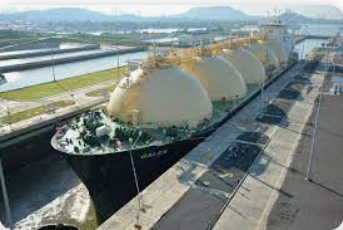There’s a disturbance in the force of global shipping, as if a major transit point started slipping away.
There’s a very serious problem occurring a few thousand miles to the south of us, one that Canada could have taken tremendous advantage of, if only we had built and completed some liquified natural gas (LNG) terminals by now.
The Panama Canal, one of the wonders of the modern world that utterly changed trade and geopolitics, is drying up.
The canal, which usually handles about 36 ships a day, has in recent days reduced that to 24. By Feb. 1, it is expected to fall to 18. And the largest ships who do transit the canal have to reduce their cargoes, lest they scrape bottom.
That’s because the canal uses fresh water, captured by dams and forming the massive Gatun Lake. That fresh water is collected from ample rains. Every single time a ship passes through the canal, water used to operate the locks is flushed into the ocean. While the greatly expanded third set of locks allows much, much larger ships to use the more than 100 year-old canal, they also use a lot of water despite an innovative water recovery system. And the Canal Authority says they’ve had the lowest rains in 73 years, since 1950.
So when you add up the additional, much larger locks, with a local drought, the canal is rapidly falling into crisis. And the world is starting to take notice.
As they should, since soon half of all ships that usually use the canal will be turned away.
No one depends on the canal more than the Americans. They built it, after all, for a reason. And one of the biggest is it allows for quick access for Gulf Coast ports to Pacific markets. This was a very real reason why building a half dozen large LNG terminals made so much sense (in addition to their proximity to gas production.)
Well, a lot of that just got thrown out the window. Cutting ship transit numbers by half means a dramatic curtailment of the ability of US LNG cargoes to access the Pacific markets. Their alternative is to add something like 8,000 miles going around South America’s Cape Horn, which absolutely no one wants to do due to the treacherous weather and seas.. Otherwise, they have to cross the Atlantic, Mediterranean, Red Sea, Indian Ocean and Straits of Malacca to get to east Asia markets.
The net effect will be some cargoes from the Gulf Coast destined for Asia will have to go much, much further to deliver their product. That means fewer cargoes per ship per year. It’ll tighten up ship availability, and likely put pressure on LNG prices.
And if Canada had moved quicker on building out LNG terminals, particularly on the West Coast, we would be perfectly positioned to cash in on this situation. Not only is Kitimat, Prince Rupert and the like much, much closer to China and Japan, there’s no drying up Panama Canal to contend with, either.
Small wonder, then, Conservative Leader Pierre Poilievre chose on November 10 to post on his various social media channels, “Since Trudeau took office: 18 LNG terminals have been proposed. 0 have been completed.”
To be fair, LNG Canada, the largest proposal, is in the finishing stretch. In July they reported 85 per cent completion. In recent weeks, TC Energy reported the completion of the “golden weld” on the Coastal GasLink pipeline that will supply LNG Canada and presumably other facilities on the West Coast. Without pipeline, which was both massively delayed and overbudget, no small thanks to pipeline protesters, LNG Canada would be useless.
Other projects are finally gaining traction – Woodfibre LNG at Squamish on the south coast, and Ksi Lisims LNG right on the Alaska/BC border, and Cedar LNG, a floating LNG terminal adjacent to LNG Canada and served by Coastal GasLink.
Remember when the German chancellor came to Canada, seeking LNG, and was told by Prime Minister Justin Trudeau there was “no business case?” And then the Japanese prime minister was told something similar a few weeks later?
The Ukraine War has proven a business case for almost two years in the Atlantic basin. The Panama Canal reduction in service will soon prove it in the Pacific. What more do we need?
Canada should have built these projects years ago. We’d be securing markets and cashing in today.
No business case, indeed.
Brian Zinchuk is editor and owner of PipelineOnline.ca, and occasional contributor to the Frontier Centre for Public Policy. He can be reached at brian.zinchuk@pipelineonline.ca.



